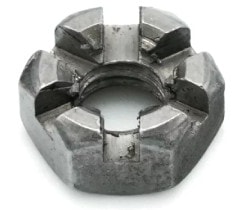Slotted Nuts provide positive locking in high vibration and motion applications, such as automotive. The slots can accommodate a cotter, split, or taper pin or wire, which prevents a nut from loosening. Slotted hex nuts are nuts with portions cut out designed to be used with a cotter ping to create a locking mechanism. These nuts are similar to a castle nut but have a lower profile which sometimes makes them a better option. Slotted Cuts in the Top of the Hex Allow for Insertion of Pins.

| Metric : | Dia M8 - M24 |
|---|---|
| Threads : | Metric Coarse/Fine |
| Strength : | CL5 & A4-70 |
| Material/Finish : | Zinc Plated & Stainless Steel |
| Compliance : | DIN 935 |
Slotted Hex Nuts are hex nuts with slots protruding from the top, similar to castle nuts. To use a slotted nut, a hole is drilled through the threaded portion of a bolt or stud. A cotter pin is then placed through the slots and hole and deformed so it cannot easily be removed. This creates a locking effect that prevents the nut from spinning free of the bolt or stud.
Slotted nuts are similar to castle nuts but usually have a lower profile than a castle nut of the same size. Slotted hex nuts are generally preferred to castle nuts due to their lower profile. The cotter pin locks the slotted nut into place, which eliminates the need for other locking-type fasteners. This means no lock washers are needed when using a slotted nut.
*If the bolt has no hole, once it is torqued properly drill a hole between two of the slots
